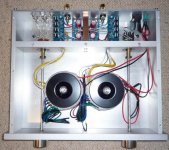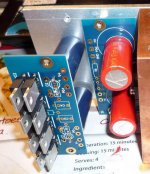Hi,
a monoblock power amplifier is just that.
I have found that adding two of these together and inserting them into the same case (to classI standard) to make a dual mono compromises the design/performance.
As soon as you start sharing any of the components, eg. the transformer, I find that compromises the performance even more.
Peter is right, if the secondaries are shared between the channels then you must address this in the way you design the downstream side.
It is a stereo amplifier, not a dual mono and must be designed as such.
a monoblock power amplifier is just that.
I have found that adding two of these together and inserting them into the same case (to classI standard) to make a dual mono compromises the design/performance.
As soon as you start sharing any of the components, eg. the transformer, I find that compromises the performance even more.
Peter is right, if the secondaries are shared between the channels then you must address this in the way you design the downstream side.
It is a stereo amplifier, not a dual mono and must be designed as such.
Thanks for your advise.
So the best thing to do, would be to buy another transformer and run the 2 boards from seperate transformers?
So the best thing to do, would be to buy another transformer and run the 2 boards from seperate transformers?
if money is no concern then I would recommend two monoblocks.
That does not = best value.
Separate secondaries (4 instead of 2) can achieve just as much isolation between channels in a two channel amplifier as a pair of transformers. But you may be cheaper installing two transformers than trying to source an expensive 4 secondary transformer.
The crosstalk between two transformers and a single 4secondary transformer will be better. Again a compromise.
There is no "best".
You set your budget and try to identify what can be achieved within your budget.
That does not = best value.
Separate secondaries (4 instead of 2) can achieve just as much isolation between channels in a two channel amplifier as a pair of transformers. But you may be cheaper installing two transformers than trying to source an expensive 4 secondary transformer.
The crosstalk between two transformers and a single 4secondary transformer will be better. Again a compromise.
There is no "best".
You set your budget and try to identify what can be achieved within your budget.
ok cheers
Should the PG+/PG- all connect to SG and then CHG or am i misunderstanding PD's earlier post?
This is my first project so im abit of a newbie. I have read PD's posts but i find it easier to read a circuit diagram than to try and interpret wording.
Thanks again
Dan
Should the PG+/PG- all connect to SG and then CHG or am i misunderstanding PD's earlier post?
This is my first project so im abit of a newbie. I have read PD's posts but i find it easier to read a circuit diagram than to try and interpret wording.
Thanks again
Dan
dannycelluk said:Should the PG+/PG- all connect to SG and then CHG or am i misunderstanding PD's earlier post?
In a stereo setup, PG+/PG- should be connected to central point on a wire connecting OG (output grounds) of both channels, from here you run another wire for chassis connection.
SG pads are used for input connection only (from RCAs or potentiometer)
cyxg,
what caps are those on the rectifier pcbs? What are the results of using different value caps on the rectifier boards? (sorry noobie here) Also, where did u get that chassis, im struggling to find good aus cases haha?
what caps are those on the rectifier pcbs? What are the results of using different value caps on the rectifier boards? (sorry noobie here) Also, where did u get that chassis, im struggling to find good aus cases haha?
beauistheman said:cyxg,
what caps are those on the rectifier pcbs? What are the results of using different value caps on the rectifier boards? (sorry noobie here) Also, where did u get that chassis, im struggling to find good aus cases haha?
it's panasonic caps on the rectifier pcbs.
chassis is DIY by my self, use CNC machine.
Attachments
beauistheman said:what values are the caps?? What changes are made by altering the values for these?
1500uF 50v ¨C Panasonic FC Capacitor
I'd like to share some experience about this project.
I've built dual mono amp,but with two amps on each channel(for bi-amping).On the bass channels I have 2200uF Pana FC's,and on the treble channels I have 100uF BG STD.Another difference is in the resistor quality.On treble I have Caddock's 22K.Everything else is the same.Rail is 36V,and my speakers are Jamo Concert VII.Cd player is Yamaha cdx-993.
First I've tried classic dual mono with just two boards with 2200uF(with jumpers on the speakers),and first impressions was just stunning,then I decide to go with another pair of amps for driving trebles.But from the first listening sound was not the same.Imaging was worse,transparency also,and with the time(three or more months) sound became harsh and grainy with metal note around voices and some instruments(clapping hands on live recordings),more sibilants.
Today I have connect speakers like in the first place and voila,sound is great again!
What can be the reason for this happening?
I've built dual mono amp,but with two amps on each channel(for bi-amping).On the bass channels I have 2200uF Pana FC's,and on the treble channels I have 100uF BG STD.Another difference is in the resistor quality.On treble I have Caddock's 22K.Everything else is the same.Rail is 36V,and my speakers are Jamo Concert VII.Cd player is Yamaha cdx-993.
First I've tried classic dual mono with just two boards with 2200uF(with jumpers on the speakers),and first impressions was just stunning,then I decide to go with another pair of amps for driving trebles.But from the first listening sound was not the same.Imaging was worse,transparency also,and with the time(three or more months) sound became harsh and grainy with metal note around voices and some instruments(clapping hands on live recordings),more sibilants.
Today I have connect speakers like in the first place and voila,sound is great again!
What can be the reason for this happening?
I'd like to share some experience about this project.
I've built dual mono amp,but with two amps on each channel(for bi-amping).On the bass channels I have 2200uF Pana FC's,and on the treble channels I have 100uF BG STD.Another difference is in the resistor quality.On treble I have Caddock's 22K.Everything else is the same.Rail is 36V,and my speakers are Jamo Concert VII.Cd player is Yamaha cdx-993.
First I've tried classic dual mono with just two boards with 2200uF(with jumpers on the speakers),and first impressions was just stunning,then I decide to go with another pair of amps for driving trebles.But from the first listening sound was not the same.Imaging was worse,transparency also,and with the time(three or more months) sound became harsh and grainy with metal note around voices and some instruments(clapping hands on live recordings),more sibilants.
Today I have connect speakers like in the first place and voila,sound is great again!
What can be the reason for this happening?
I've built dual mono amp,but with two amps on each channel(for bi-amping).On the bass channels I have 2200uF Pana FC's,and on the treble channels I have 100uF BG STD.Another difference is in the resistor quality.On treble I have Caddock's 22K.Everything else is the same.Rail is 36V,and my speakers are Jamo Concert VII.Cd player is Yamaha cdx-993.
First I've tried classic dual mono with just two boards with 2200uF(with jumpers on the speakers),and first impressions was just stunning,then I decide to go with another pair of amps for driving trebles.But from the first listening sound was not the same.Imaging was worse,transparency also,and with the time(three or more months) sound became harsh and grainy with metal note around voices and some instruments(clapping hands on live recordings),more sibilants.
Today I have connect speakers like in the first place and voila,sound is great again!
What can be the reason for this happening?
kele1975, those caps you mentioned, are they on the rectifier pcb? Noting my low electronics knowledge, what is the effect of changing the cap values on the amp pcb?
beauistheman said:kele1975, those caps you mentioned, are they on the rectifier pcb? Noting my low electronics knowledge, what is the effect of changing the cap values on the amp pcb?
Caps are beside chips.On rect.boards I have 2x10uF Pana FC.
ok no worries, what are the effects when changing rec.board caps, and what about when you change the values of the caps on the chip boards?
Have you read the thread from beginning?
You can also try here:
http://www.diyaudio.com/forums/showthread.php?postid=581230#post581230
You can also try here:
http://www.diyaudio.com/forums/showthread.php?postid=581230#post581230
yeah i have read through it, but i get confused sometimes. In one set of pictures caps are installed on the rect board, then in another, the caps are gone and different caps are installed on the amp board etc. Im trying to figure out the effects that each component has on how the system operates. In some pics there are no caps on the rect board and no resistors on the amp board.
I dunno, i just get confused because i keep expecting it all to be the same and i believe the kit has different components now. Anyways...
I dunno, i just get confused because i keep expecting it all to be the same and i believe the kit has different components now. Anyways...
Check this post about caps on rect board: http://www.diyaudio.com/forums/showthread.php?postid=1508953#post1508953
In my case,maybe the value is to low(100uF on chip,and 10uF on rect).What do you think?
Can that be the reason of my problems(five posts above)?
Can that be the reason of my problems(five posts above)?
kale1975,
were you saying that you were having problems with the amps while biamping (in the way you described?). But when using dual mono (no biamping) you were getting good results?
what is your reasoning for using only 100uf on the amp board?
were you saying that you were having problems with the amps while biamping (in the way you described?). But when using dual mono (no biamping) you were getting good results?
what is your reasoning for using only 100uf on the amp board?
- Home
- More Vendors...
- Audio Sector
- Commercial Gainclone kit- building instructions

